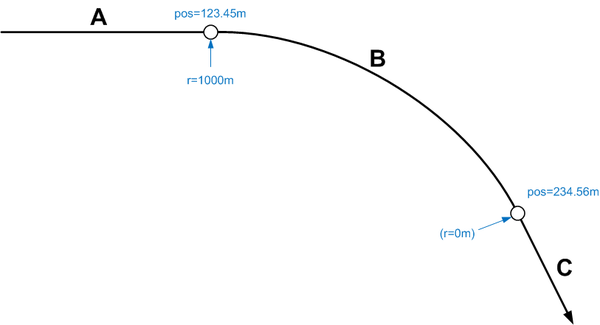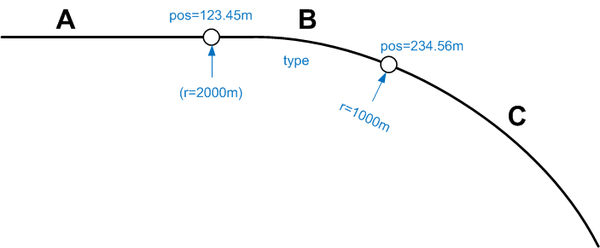Template:Table/Template:InheritValueTable: Difference between revisions
| [unchecked revision] | [unchecked revision] |
No edit summary |
No edit summary |
||
| Line 1: | Line 1: | ||
{{elementDocu | |||
|elementName=Ferri Leberl/spielwiese | |||
|parent={{IS:Tag|}} | |||
|childs=''None'' | |||
|semantics={{missing information|topic=the semantics|user=[[User:Ferri Leberl|Ferri Leberl]] ([[User talk:Ferri Leberl|talk]]) 10:23, 24 February 2017 (CET)}} | |||
|inheritedAttributes=''None'' | |||
|ownAttributes=''None'' | |||
|constraints=''None'' | |||
|bestpractice=== Best practice / {{Deu|Empfohlene Anwendung}} / {{Fra|Bonnes pratiques}} == | |||
===Modelling of curves=== | |||
Let’s consider a simple example where a circular arc (B) of radius 1000 meters is directly connected on both ends with straight track segments (A, C). The situation looks like this: | |||
[[file:CurveExample 170213 02.png|600px]] | |||
In railML, the horizontal curves are modelled using {{IS:Tag|radiusChange}} elements that are positioned everywhere along the track where the radius changes. The railML syntax for this example shall look like this: | |||
<pre> | |||
<track ...> | |||
... | |||
<trackElements> | |||
<radiusChange id="rC0815" pos="123.45" radius="1000"/> | |||
<radiusChange id="rC4711" pos="234.56" radius="0"/> | |||
</trackElements> | |||
</track> | |||
</pre> | |||
In this example, the first {{IS:Tag|radiusChange}} point (rC0815) is situated at the connection of the straight track segment (A) with the circular arc (B). The parameter @radius of the {{IS:Tag|radiusChange}} element describes the new value of the radius (1000 meters) that is valid from there into the direction of track orientation. The track orientation is indicated by the arrow at the right end. | |||
* | The second {{IS:Tag|radiusChange}} point (rC4711) is situated at the connection of the circular arc (B) with the straight track segment (C). Like for the previous {{IS:Tag|radiusChange}}, the parameter @radius describes the new value of the radius that is valid from there into the direction of track orientation. Normally, this value should be ''infinite'', but since ''infinite'' is not an explicit number, railML uses the value ''0'' here. | ||
===Modelling of transition curves in railML 2.3=== | |||
With railML version 2.3 the element {{IS:Tag|radiusChange}} has been extended by the new attribute @geometryElementDescription. This attribute is an enumeration parameter, which provides the following entries to enable a more detailed description of transition curves: | |||
*TS_cubicParabola | |||
*TS_parabola4 | |||
*TS_clothoide | |||
*TS_WienerBogen | |||
*TS_BlossBogen | |||
*TS_Sinusoide | |||
*TS_Cosinusoide | |||
*SC | |||
*(any other) | |||
The new attribute @geometryElementDescription in the {{IS:Tag|radiusChange}} element shall be used for modeling begin and end points of transition curves. | |||
Let’s consider an example where a straight track segment (A) is connected with a circular arc (C) of radius 1000 meters via a clothoide (B). The situation looks like this: | |||
[[file:transitionCurveExample 170213 02.png|600px]] | |||
{{ | In railML, the transition curve is modelled using two {{IS:Tag|radiusChange}} elements that are positioned at the begin and at the end of the transition curve. The railML syntax for this example shall look like this: | ||
<pre> | |||
<track ...> | |||
... | |||
<trackElements> | |||
<radiusChange id="rC0815" pos="123.45" radius="2000" geometryElementDescription="TS_clothoide"/> | |||
<radiusChange id="rC4711" pos="234.56" radius="1000" geometryElementDescription="SC"/> | |||
</trackElements> | |||
</track> | |||
</pre> | |||
In this example, the first {{IS:Tag|radiusChange}} point (rC0815) indicates the begin of a transition curve of type ''Clothoide''. Since the parameter @radius is mandatory for every {{IS:Tag|radiusChange}} element, a fixed value has to be provided although the main feature of a transition curve is its changing radius. It is recommended to use twice the value of the radius of the circular arc to which the transition curve is connected. In the given example, the value is 2000 meters. | |||
The second {{IS:Tag|radiusChange}} point indicates the end of the transition curve and the begin of the circular arc. The circular arc has a radius of 1000 meters. | |||
}} | |||
Revision as of 11:23, 24 February 2017
Ferri Leberl/spielwiese
Scheme description / Schemenbeschreibung
Position of Ferri Leberl/spielwiese in the XML-Tree / Position von Ferri Leberl/spielwiese im XML-Baum
- Parent: <[[IS:_|]]>
- Children: None
Multiplicity / Anzahl
Semantics / Bedeutung
|
Attributes of Ferri Leberl/spielwiese / Attribute von Ferri Leberl/spielwiese
None
Syntactic Constraints / Syntaktische Beschränkungen
None
Best practice & Examples / Empfohlene Anwendung & Beispiele
Best practice / Empfohlene Anwendung /
Modelling of curves
Let’s consider a simple example where a circular arc (B) of radius 1000 meters is directly connected on both ends with straight track segments (A, C). The situation looks like this:
In railML, the horizontal curves are modelled using <radiusChange> elements that are positioned everywhere along the track where the radius changes. The railML syntax for this example shall look like this:
<track ...>
...
<trackElements>
<radiusChange id="rC0815" pos="123.45" radius="1000"/>
<radiusChange id="rC4711" pos="234.56" radius="0"/>
</trackElements>
</track>
In this example, the first <radiusChange> point (rC0815) is situated at the connection of the straight track segment (A) with the circular arc (B). The parameter @radius of the <radiusChange> element describes the new value of the radius (1000 meters) that is valid from there into the direction of track orientation. The track orientation is indicated by the arrow at the right end.
The second <radiusChange> point (rC4711) is situated at the connection of the circular arc (B) with the straight track segment (C). Like for the previous <radiusChange>, the parameter @radius describes the new value of the radius that is valid from there into the direction of track orientation. Normally, this value should be infinite, but since infinite is not an explicit number, railML uses the value 0 here.
Modelling of transition curves in railML 2.3
With railML version 2.3 the element <radiusChange> has been extended by the new attribute @geometryElementDescription. This attribute is an enumeration parameter, which provides the following entries to enable a more detailed description of transition curves:
- TS_cubicParabola
- TS_parabola4
- TS_clothoide
- TS_WienerBogen
- TS_BlossBogen
- TS_Sinusoide
- TS_Cosinusoide
- SC
- (any other)
The new attribute @geometryElementDescription in the <radiusChange> element shall be used for modeling begin and end points of transition curves. Let’s consider an example where a straight track segment (A) is connected with a circular arc (C) of radius 1000 meters via a clothoide (B). The situation looks like this:
In railML, the transition curve is modelled using two <radiusChange> elements that are positioned at the begin and at the end of the transition curve. The railML syntax for this example shall look like this:
<track ...>
...
<trackElements>
<radiusChange id="rC0815" pos="123.45" radius="2000" geometryElementDescription="TS_clothoide"/>
<radiusChange id="rC4711" pos="234.56" radius="1000" geometryElementDescription="SC"/>
</trackElements>
</track>
In this example, the first <radiusChange> point (rC0815) indicates the begin of a transition curve of type Clothoide. Since the parameter @radius is mandatory for every <radiusChange> element, a fixed value has to be provided although the main feature of a transition curve is its changing radius. It is recommended to use twice the value of the radius of the circular arc to which the transition curve is connected. In the given example, the value is 2000 meters. The second <radiusChange> point indicates the end of the transition curve and the begin of the circular arc. The circular arc has a radius of 1000 meters.
Notes / Anmerkungen
Not yet described. / Noch nicht beschrieben.
Open issues / Offene Punkte/Pendenzen
Not yet described. / Noch nicht beschrieben.


